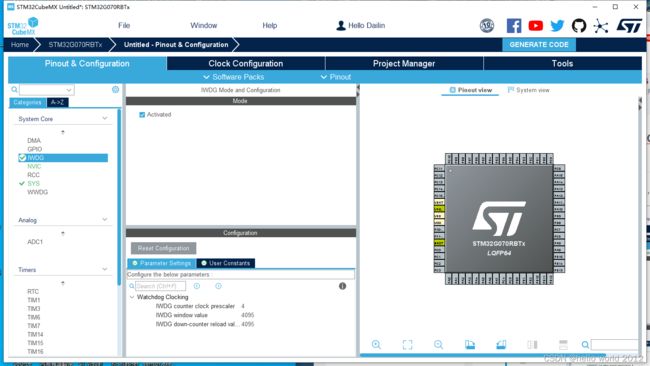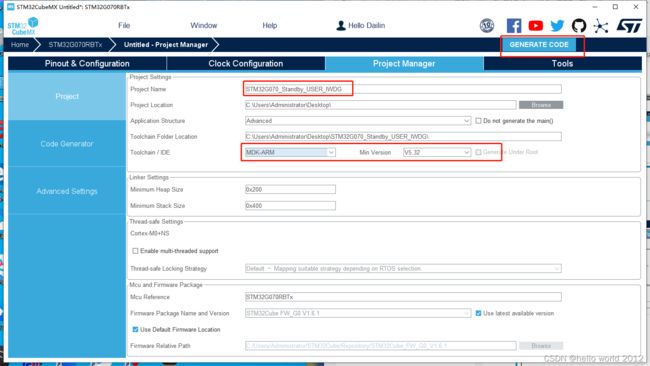- 单片机 - 串行通信 & 并行通信、接口类型及常见通信协议详细解析
Peter_Deng.
单片机嵌入式硬件
串行通信、并行通信、接口类型及常见通信协议详细解析1.并行通信vs.串行通信通信方式主要分为并行通信(ParallelCommunication)和串行通信(SerialCommunication),两者的主要区别在于数据传输的方式。1.1并行通信(ParallelCommunication)概念:并行通信使用多条数据线同时传输多个数据位(bit),通常需要单独的时钟信号进行同步。优点:速度快,适
- 雅特力AT32F435学习——3.PWM实验
数字梦想家
学习
PWM实验定时器浑身都是包其中PWM占大头,因为PWM应用太广了:呼吸灯、电机、蜂鸣器,生日火炬里的声音都是PWM干的,接下来就让我们学一下雅特力AT32F435单片机的PWM吧。基础知识老样子对于PWM的基础了解那肯定直接从数据手册学起,先要从头到尾过一遍。PWM是高级功能不是一般的定时器就能有的,所以第一时间就要看数据手册看看哪些定时器用PWM功能,并且确认PWM输入输出的通道和引脚,本次教学
- STM32F1基于HAL库的学习记录实用使用教程分享(五、PWM驱动舵机、呼吸灯)
藤樂.
STM32学习stm32学习数据库
往期内容STM32F1基于HAL库的学习记录实用使用教程分享(一、GPIO_Output)STM32F1基于HAL库的学习记录实用使用教程分享(二、GPIO_Input按键)STM32F1基于HAL库的学习记录实用使用教程分享(三、外部中断按键)STM32F1基于HAL库的学习记录实用使用教程分享(四、OLEDIIC驱动软件IIC硬件IIC)文章目录往期内容前言一、PWMPWM如何控制LED亮度?
- STM32 Cube MX 软件使用教程和技巧(纯干货分享~~!)
立量
嵌入式IDEstm32单片机嵌入式硬件
以下是关于STM32CubeMX的详细使用教程和一些实用技巧,帮助您快速上手并高效开发STM32项目:一、STM32CubeMX简介功能:ST官方推出的图形化配置工具,用于生成STM32微控制器的初始化代码(基于HAL库/LL库),支持引脚分配、时钟树配置、外设初始化等。优势:减少底层代码编写时间,避免手动配置寄存器,兼容多种IDE(Keil、IAR、STM32CubeIDE等)。二、基础使用教程
- 蓝桥杯单片机刷题——串口发送显示
lzb759
一个月备赛蓝桥杯单片机蓝桥杯单片机
设计要求通过串口接收字符控制数码管的显示,PC端发送字符'A',数码管显示'A',发送其它非法字符时,数码管显示'E'。数码管显示格式如下:备注:单片机IRC振荡器频率设置为12MHz。串口通信波特率:9600bps。按键模式:BTN;扩展方式:IO模式除字符'A'外,其它字符均为非法字符。个人代码#includecodeunsignedcharSeg_Table[]={0x88,//A00x86
- 【STM32实物】基于STM32的扫地机器人/小车控制系统设计
阿齐Archie
单片机项目合集stm32机器人单片机mcu
基于STM32的扫地机器人/小车控制系统设计演示视频:基于STM32的扫地机器人小车控制系统设计简介:扫地机器人系统采用分层结构设计,主要包括底层硬件控制层、中间数据处理层和上层用户交互层。底层硬件控制层负责对各个硬件模块进行控制和数据采集,中间数据处理层负责对采集到的数据进行处理和解算,上层用户交互层负责与用户进行交互并显示系统状态信息。主控模块采用STM32F103C8T6开发板,具有高性能、
- 基于STM32单片机的智能清扫小车清扫机器人
CC呢
单片机stm32机器人
功能描述STM32单片机+循迹+避障+蓝牙控制+温度采集+声光报警+按键调节+OLED显示+风扇吸尘1.STM32单片机为控制核心2.通过ds18b20传感器测量环境温度3.OLED显示屏显示模式及测量的信息;4.通过红外循迹传感器可以实现小车沿黑线进行循迹清扫5.通过两路红外光电传感器进行避障,可以实现全屋随意清扫6.蓝牙通信,可以通过手机公共APP(蓝牙串口调试助手)实现控制小车的前进方向,遥
- 远程视像搬运小车控制系统设计(源码+万字报告+实物)
炳烛之明科技
stm32嵌入式硬件单片机
目录第1章绪论11.1研究目的及意义11.2国内外研究现状21.3主要研究内容3第2章系统的总体结构42.1总体方案设计42.2功能需求分析42.2.1技术路线42.3单片机型号选择5第3章系统的硬件部分设计63.1系统总体设计63.2系统的主要功能模块设计63.2.1蜂鸣器电路模块设计63.2.2YX4055AM驱动电路模块设计73.2.3按键电路模块设计73.2.4颜色识别传感器模块设计83.
- 【STM32】智能避障红外小车
Alioooooooon
嵌入式stm32单片机嵌入式硬件
文章目录直流电机`motor.c/motor.h`红外对管红外循迹利用脉冲宽度调制技术(PWM)控制电机转速避障`red.c/red.h`编译环境:keil5SourceInsightSTM32F103X原理图:直流电机直流电机的原理:通电就会转,反向通电就会反转两极的电势差决定转速电机驱动模块以及接线参考图示代码实现:motor.c/motor.h#ifndef__MOTOR_H__#defin
- stlink is not in the dfu mode,please restart it
litvm
bug解决经验分享
问题:Keil中使用stlink烧录代码时,提示需要更新驱动,点击更新后,提示:“STLINKisnotintheDFUmodeplesserestartit”,重新拔插之后,还是同样的问题解决方法:stlink已经连接了STM32F103(VCC,GND,SWCLK,SWDIO四个引脚),在连接状态下,插入电脑进行更新是不行的,也就是所谓的notinthedfumode。只需要把stlink与S
- 使用定时器中断进行延时,取代delay,不影响主流程的运行
litvm
bug解决经验分享单片机嵌入式硬件
在单片机开发中,我们经常会用到延时函数-delay();比如LED的闪烁、ADC采集、向其他设备发送指令后等待回复数据等等,应用非常广泛,也很好用。但它也有一个致命的缺点——死等,举个例子,一个工程中有A、B、C三个任务,如果是裸机开发,不考虑中断的话,它会按while(1)中固定的顺序去执行。由于任务需要,B中会经常delay_ms(500);,那么在delay过程中,整个程序都会在B中等待50
- MCS51指令系统及汇编程序设计
cxz204986
51单片机
一、MSC--51指令系统包含111条基本指令。指令:是CPU按照人的意图来完成某种操作的命令,它以英文名称或缩写形式作为助记符。掌握MCS-51汇编语言指令是51单片机汇编设计程序的基础。按所占字节分,MCS-51指令分三种:(1)单字节指令49条:(2)双字节指令45条;(3)三字节指令17条。按执行时间分,MCS-51指令分三种:(1)1个机器周期指令64条;(2)2个机器周期指令45条;(
- HAL库中使用空闲中断+DMA接收数据,接收失败的问题
litvm
bug解决bugHAL库
问题:串口屏与单片机通过串口(USART1)进行通信,调试时发现问题,现象如下:手动页面的几个文本,输入的数字不会显示出来,比如初始值为0,输入200,200会一闪而过,又恢复到0。检查了页面ID和文本ID,单片机解析的函数都没有问题。①连接上调试器时,文本输入、显示非常正常。②不接调试器时,文本输入、显示时而正常,时而有问题。解决:1,不知道哪里的原因,接上调试器时又运行正常,没法调试。所以只能
- 基于STC89C52的8255并行口拓展实验
@小张要努力
mongodb数据库学习单片机proteus嵌入式硬件51单片机
摘要本文围绕基于STC89C52单片机的8255并行口扩展实验展开,详细阐述实验原理、硬件设计、软件编程及Proteus仿真实现过程。通过扩展8255芯片,实现单片机I/O口资源的灵活应用,完成对LED阵列的控制,验证8255并行口扩展在单片机系统中的实用性,为单片机外围接口扩展应用提供实践参考。一、引言STC89C52作为经典的51系列单片机,在工业控制、嵌入式系统等领域应用广泛。然而,其内部I
- STM32:关于NVIC的工作与优先级分组方式
sewinger
stm32学习笔记单片机嵌入式硬件stm32
一,NVIC是什么NVIC,全称是NestedVectoredInterruptController,即嵌套向量中断控制器。它是ARMCortex-M系列处理器内核的一个重要组成部分,主要用于管理中断请求,协调中断的优先级,以及控制中断的嵌套执行,使得处理器能够高效、有序地响应和处理多个中断源。这个名称是如何体现的,下面一一说明。二,“嵌套”体现在哪?NVIC的嵌套体现在它能够处理多个中断的嵌套执
- 于STM32F103C8T6的智能灯泡控制系统C++源码实现
程序员Thomas
STM32单片机智能灯泡stm32c++嵌入式硬件
以下是一个基于STM32F103C8T6的智能灯泡控制系统C++源码实现,整合了PWM调光、WiFi控制和环境感知功能。该代码已在STM32CubeIDE中验证,支持直接烧录运行:#include"main.h"#include#include"wifi.h"//LED设备抽象类(3设计)classLEDDevice{protected:TIM_HandleTypeDef*pwmTimer;uin
- 基于STM32的平衡车外设控制应用案例,提供C++源码
程序员Thomas
STM32单片机平衡车stm32c++单片机
基于STM32的平衡车外设控制应用案例**下面是一个使用STM32控制平衡车的简单应用案例,包含姿态传感器读取、电机控制和串口通信功能。主要功能使用MPU6050传感器读取姿态数据使用PID控制器调整平衡车姿态通过串口输出调试信息电机速度控制C++源代码#include"stm32f10x.h"#include//定义常量#definePWM_MIN1000#definePWM_MAX2000#d
- stc89c51单片机音乐盒系统设计_基于单片机STC89C52的数字音乐盒设计
Fax Caelestis
基于单片机STC89C52的数字音乐盒设计1基于单片机STC89C52的数字音乐盒设计一、引言1.1设计的目的通过课程设计,让学生熟悉单片机微机应用系统开发、研制的过程,软硬件设计的工作方法、工作内容、工作步骤。对学生进行基本技能训练,例如:组成系统、编程、调试、查阅资料、焊接电路板等。使学生理论联系实际,提高动手能力和分析问题、解决问题的能力。1.2设计的基本要求(1)利用I/O口产生一定频率的
- 基于 STC89C52 的 8x8 点阵显示数字
@小张要努力
单片机嵌入式硬件stm3251单片机proteus
一、引言在电子设计领域,信息的有效展示是众多项目的关键环节。8x8点阵作为一种经济且实用的显示模块,能够呈现数字、简单字母及图形等信息,在电子时钟、简易游戏机等产品中广泛应用。STC89C52单片机凭借其低成本、丰富的I/O资源与稳定的性能,成为驱动8x8点阵的理想选择。本文将深入探讨如何利用STC89C52单片机结合74LS245芯片,实现8x8点阵的数字显示功能,并借助Proteus软件进行仿
- 基于 STC89C52 的智能秒表
@小张要努力
单片机stm3251单片机proteusmcuc++c语言
引言秒表作为一种常见的计时工具,在体育赛事、实验测量等众多场景中有着广泛应用。随着电子技术的发展,基于单片机的智能秒表凭借其高精度、多功能等优势逐渐取代传统机械秒表。本文将详细介绍一款基于STC89C52单片机的智能秒表设计,该秒表通过两位数码管进行时间显示。STC89C52单片机特性回顾STC89C52是一款性能卓越的8位CMOS微控制器。它拥有8K字节的系统可编程Flash存储器,可方便地存储
- stm32-定时器
Amy.com
stm32嵌入式硬件单片机
一、定时器PLL锁相环:作用是倍频prescale:降频2440芯片定时器配置2.代码:t&=~((0xff<<12)|(0x3f<<4)|(3<<0));t|=(127<<12);t|=(2<<4);t|=(1<<0);CLKDIVN|=(2<<1)|(1<<0);二、PWM定时器控制寄存器单稳态:执行一次后关闭间隙模式:反复执行
- 多个单片机之间的SPI主从通讯
菜长江
单片机嵌入式硬件
工程文件链接:链接:https://pan.baidu.com/s/1RXp9lw2ZqyglQSwKnw7Siw?pwd=6666提取码:6666工程里面有很多例子都是看B站视频手打的(这次代码只用到了YJSPI文件夹下面的.C和.H文件其余可以忽略),只是验证通讯和配置一,概述1.因为工作是从事PCBA测试软件开发的(上位机),之前做过的很多项目都是一个单片机完成所有功能,做了有段时间了无非就
- stm32定时器实现 微秒延时
随风飘零翼
stm32stm32单片机嵌入式硬件
Cubemx配置图初始化无需使能定时器中断。代码如下:voiddelay_us(uint16_tus){uint16_tdiffer=0xffff-us-5;__HAL_TIM_SET_COUNTER(&htim17,differ);//清空定时器17HAL_TIM_Base_Start(&htim17);//启动定时器while(differ<0xffff-5){//计算differ=__HAL
- H743定时器输出PWM波方法(基于STM32CubeMX)
NW嵌入式开发
单片机开发stm32定时器PWM模式
0工具准备1.STM32CubeMX2.《STM32H743参考手册中文版》3.《stm32h743xi数据手册》1前言本文介绍基于STM32CubeMX,使用stm32h743xi,使用TIM15的通道2输出PWM波的方法。2H743定时器输出PWM波方法(基于STM32CubeMX)《STM32H743参考手册中文版》对PWM模式的描述如下:其中,有关PWM模式1和模式2的介绍见TIM15_C
- STM8L1xx利用定时器实现毫秒和微妙延时
荣070214
STM8单片机单片机毫秒和微妙延时
采用单片机的定时计数器进行毫秒和微妙级延时,精度较准。检测溢出时产生的标志位来判断延时到达。下面以STM8L101芯片为例及配合代码说明。一、实现原理:1、初始化Timer2时钟源(附上相应代码)voidTIM2Init(void){TIM2_DeInit();CLK_PeripheralClockConfig(CLK_Peripheral_TIM2,ENABLE);TIM2->CR1&=((ui
- 入门级带你实现一个安卓智能家居APP(2)kotlin版本
一粒程序米
androidkotlin智能家居WiFi单片机
前言上一篇写过java版本的实现,这一篇就写一下kotlin版本的吧。效果展示本APP是通过tcp/ip协议与连了WiFi的单片机通信。其实除了主活动类和新建项目时有一丢丢不同,其他的都是一样的哈~第一步:你得会一点点kotlin基础,建议看一本书,是郭霖大神些的《第一行代码》第三版,里面除了安卓的基础教学,还有kotlin的。第二步:建议看一本书,是郭霖大神些的《第一行代码》,先入门安卓基础。不
- 如何一键修改MDK代码风格以及error in include chain (cmsis_armcc.h): expected identfieror报错解决方法
superior tigre
单片机单片机stm32嵌入式硬件
目录一、修改MDK代码风格的两种方法1.直接设置2.替换global.prop文件,一键设置二、errorinincludechain(xxxxxxx.h):expectedidentfieror等报错的解决方法一、修改MDK代码风格的两种方法最近在学习某原子stm32的HAL库视频,被教学代码的风格深深吸引,感觉keil默认代码风格是越看越别扭,所以决定自己修改一下代码的格式,总结了两种方法,这
- 【江协STM32】11-2/3 W25Q64简介、软件SPI读写W25Q64
冰糖雪莲IO
stm32嵌入式硬件单片机
1.W25Q64简介W25Qxx系列是一种低成本、小型化、使用简单的非易失性存储器,常应用于数据存储、字库存储、固件程序存储等场景存储介质:NorFlash(闪存)时钟频率:80MHz/160MHz(DualSPI)/320MHz(QuadSPI)存储容量(24位地址):W25Q40:4Mbit/512KByteW25Q80:8Mbit/1MByteW25Q16:16Mbit/2MByteW25Q
- STM32F103C8T6点灯/流水灯(指定IO,正向反向)
BDXiaotianYA
stm32嵌入式硬件单片机
参加2023年电赛后,到现在上班一年多,长达两年时间内,几乎没有再碰过单片机,由于现在工作中需要接触到一些代码,先退回来复习下32单片机。本人在此做一件事情,傻瓜式代码,让代码足够简洁,足够规范,让你复制我的代码百分百能够使用。此账号仅作为分享本人复习过程中记录使用,如果无法使用,或者或者有优化的地方,欢迎留言,看到后第一时间给予回复。有空会将2023激光打靶代码开源出来。在使用本程序的时候,默认
- STM32八股【2】-----ARM架构
Invinciblenuonuo
stm32arm开发架构
1、架构包含哪几部分内容寄存器处理模式流水线MMU指令集中断FPU总线架构2、以STM32为例进行介绍2.1寄存器寄存器名称作用R0-R3通用寄存器用于数据传递、计算及函数参数传递;R0也用于存储函数返回值。R4-R12通用寄存器用于存储局部变量,减少频繁的内存访问。R13栈指针(SP)指向当前栈顶,负责管理栈操作。分为主栈指针(MSP)和进程栈指针(PSP):系统中断处理和普通任务可以使用不同的
- [黑洞与暗粒子]没有光的世界
comsci
无论是相对论还是其它现代物理学,都显然有个缺陷,那就是必须有光才能够计算
但是,我相信,在我们的世界和宇宙平面中,肯定存在没有光的世界....
那么,在没有光的世界,光子和其它粒子的规律无法被应用和考察,那么以光速为核心的
&nbs
- jQuery Lazy Load 图片延迟加载
aijuans
jquery
基于 jQuery 的图片延迟加载插件,在用户滚动页面到图片之后才进行加载。
对于有较多的图片的网页,使用图片延迟加载,能有效的提高页面加载速度。
版本:
jQuery v1.4.4+
jQuery Lazy Load v1.7.2
注意事项:
需要真正实现图片延迟加载,必须将真实图片地址写在 data-original 属性中。若 src
- 使用Jodd的优点
Kai_Ge
jodd
1. 简化和统一 controller ,抛弃 extends SimpleFormController ,统一使用 implements Controller 的方式。
2. 简化 JSP 页面的 bind, 不需要一个字段一个字段的绑定。
3. 对 bean 没有任何要求,可以使用任意的 bean 做为 formBean。
使用方法简介
- jpa Query转hibernate Query
120153216
Hibernate
public List<Map> getMapList(String hql,
Map map) {
org.hibernate.Query jpaQuery = entityManager.createQuery(hql);
if (null != map) {
for (String parameter : map.keySet()) {
jp
- Django_Python3添加MySQL/MariaDB支持
2002wmj
mariaDB
现状
首先,
[email protected] 中默认的引擎为 django.db.backends.mysql 。但是在Python3中如果这样写的话,会发现 django.db.backends.mysql 依赖 MySQLdb[5] ,而 MySQLdb 又不兼容 Python3 于是要找一种新的方式来继续使用MySQL。 MySQL官方的方案
首先据MySQL文档[3]说,自从MySQL
- 在SQLSERVER中查找消耗IO最多的SQL
357029540
SQL Server
返回做IO数目最多的50条语句以及它们的执行计划。
select top 50
(total_logical_reads/execution_count) as avg_logical_reads,
(total_logical_writes/execution_count) as avg_logical_writes,
(tot
- spring UnChecked 异常 官方定义!
7454103
spring
如果你接触过spring的 事物管理!那么你必须明白 spring的 非捕获异常! 即 unchecked 异常! 因为 spring 默认这类异常事物自动回滚!!
public static boolean isCheckedException(Throwable ex)
{
return !(ex instanceof RuntimeExcep
- mongoDB 入门指南、示例
adminjun
javamongodb操作
一、准备工作
1、 下载mongoDB
下载地址:http://www.mongodb.org/downloads
选择合适你的版本
相关文档:http://www.mongodb.org/display/DOCS/Tutorial
2、 安装mongoDB
A、 不解压模式:
将下载下来的mongoDB-xxx.zip打开,找到bin目录,运行mongod.exe就可以启动服务,默
- CUDA 5 Release Candidate Now Available
aijuans
CUDA
The CUDA 5 Release Candidate is now available at http://developer.nvidia.com/<wbr></wbr>cuda/cuda-pre-production. Now applicable to a broader set of algorithms, CUDA 5 has advanced fe
- Essential Studio for WinRT网格控件测评
Axiba
JavaScripthtml5
Essential Studio for WinRT界面控件包含了商业平板应用程序开发中所需的所有控件,如市场上运行速度最快的grid 和chart、地图、RDL报表查看器、丰富的文本查看器及图表等等。同时,该控件还包含了一组独特的库,用于从WinRT应用程序中生成Excel、Word以及PDF格式的文件。此文将对其另外一个强大的控件——网格控件进行专门的测评详述。
网格控件功能
1、
- java 获取windows系统安装的证书或证书链
bewithme
windows
有时需要获取windows系统安装的证书或证书链,比如说你要通过证书来创建java的密钥库 。
有关证书链的解释可以查看此处 。
public static void main(String[] args) {
SunMSCAPI providerMSCAPI = new SunMSCAPI();
S
- NoSQL数据库之Redis数据库管理(set类型和zset类型)
bijian1013
redis数据库NoSQL
4.sets类型
Set是集合,它是string类型的无序集合。set是通过hash table实现的,添加、删除和查找的复杂度都是O(1)。对集合我们可以取并集、交集、差集。通过这些操作我们可以实现sns中的好友推荐和blog的tag功能。
sadd:向名称为key的set中添加元
- 异常捕获何时用Exception,何时用Throwable
bingyingao
用Exception的情况
try {
//可能发生空指针、数组溢出等异常
} catch (Exception e) {
- 【Kafka四】Kakfa伪分布式安装
bit1129
kafka
在http://bit1129.iteye.com/blog/2174791一文中,实现了单Kafka服务器的安装,在Kafka中,每个Kafka服务器称为一个broker。本文简单介绍下,在单机环境下Kafka的伪分布式安装和测试验证 1. 安装步骤
Kafka伪分布式安装的思路跟Zookeeper的伪分布式安装思路完全一样,不过比Zookeeper稍微简单些(不
- Project Euler
bookjovi
haskell
Project Euler是个数学问题求解网站,网站设计的很有意思,有很多problem,在未提交正确答案前不能查看problem的overview,也不能查看关于problem的discussion thread,只能看到现在problem已经被多少人解决了,人数越多往往代表问题越容易。
看看problem 1吧:
Add all the natural num
- Java-Collections Framework学习与总结-ArrayDeque
BrokenDreams
Collections
表、栈和队列是三种基本的数据结构,前面总结的ArrayList和LinkedList可以作为任意一种数据结构来使用,当然由于实现方式的不同,操作的效率也会不同。
这篇要看一下java.util.ArrayDeque。从命名上看
- 读《研磨设计模式》-代码笔记-装饰模式-Decorator
bylijinnan
java设计模式
声明: 本文只为方便我个人查阅和理解,详细的分析以及源代码请移步 原作者的博客http://chjavach.iteye.com/
import java.io.BufferedOutputStream;
import java.io.DataOutputStream;
import java.io.FileOutputStream;
import java.io.Fi
- Maven学习(一)
chenyu19891124
Maven私服
学习一门技术和工具总得花费一段时间,5月底6月初自己学习了一些工具,maven+Hudson+nexus的搭建,对于maven以前只是听说,顺便再自己的电脑上搭建了一个maven环境,但是完全不了解maven这一强大的构建工具,还有ant也是一个构建工具,但ant就没有maven那么的简单方便,其实简单点说maven是一个运用命令行就能完成构建,测试,打包,发布一系列功
- [原创]JWFD工作流引擎设计----节点匹配搜索算法(用于初步解决条件异步汇聚问题) 补充
comsci
算法工作PHP搜索引擎嵌入式
本文主要介绍在JWFD工作流引擎设计中遇到的一个实际问题的解决方案,请参考我的博文"带条件选择的并行汇聚路由问题"中图例A2描述的情况(http://comsci.iteye.com/blog/339756),我现在把我对图例A2的一个解决方案公布出来,请大家多指点
节点匹配搜索算法(用于解决标准对称流程图条件汇聚点运行控制参数的算法)
需要解决的问题:已知分支
- Linux中用shell获取昨天、明天或多天前的日期
daizj
linuxshell上几年昨天获取上几个月
在Linux中可以通过date命令获取昨天、明天、上个月、下个月、上一年和下一年
# 获取昨天
date -d 'yesterday' # 或 date -d 'last day'
# 获取明天
date -d 'tomorrow' # 或 date -d 'next day'
# 获取上个月
date -d 'last month'
#
- 我所理解的云计算
dongwei_6688
云计算
在刚开始接触到一个概念时,人们往往都会去探寻这个概念的含义,以达到对其有一个感性的认知,在Wikipedia上关于“云计算”是这么定义的,它说:
Cloud computing is a phrase used to describe a variety of computing co
- YII CMenu配置
dcj3sjt126com
yii
Adding id and class names to CMenu
We use the id and htmlOptions to accomplish this. Watch.
//in your view
$this->widget('zii.widgets.CMenu', array(
'id'=>'myMenu',
'items'=>$this-&g
- 设计模式之静态代理与动态代理
come_for_dream
设计模式
静态代理与动态代理
代理模式是java开发中用到的相对比较多的设计模式,其中的思想就是主业务和相关业务分离。所谓的代理设计就是指由一个代理主题来操作真实主题,真实主题执行具体的业务操作,而代理主题负责其他相关业务的处理。比如我们在进行删除操作的时候需要检验一下用户是否登陆,我们可以删除看成主业务,而把检验用户是否登陆看成其相关业务
- 【转】理解Javascript 系列
gcc2ge
JavaScript
理解Javascript_13_执行模型详解
摘要: 在《理解Javascript_12_执行模型浅析》一文中,我们初步的了解了执行上下文与作用域的概念,那么这一篇将深入分析执行上下文的构建过程,了解执行上下文、函数对象、作用域三者之间的关系。函数执行环境简单的代码:当调用say方法时,第一步是创建其执行环境,在创建执行环境的过程中,会按照定义的先后顺序完成一系列操作:1.首先会创建一个
- Subsets II
hcx2013
set
Given a collection of integers that might contain duplicates, nums, return all possible subsets.
Note:
Elements in a subset must be in non-descending order.
The solution set must not conta
- Spring4.1新特性——Spring缓存框架增强
jinnianshilongnian
spring4
目录
Spring4.1新特性——综述
Spring4.1新特性——Spring核心部分及其他
Spring4.1新特性——Spring缓存框架增强
Spring4.1新特性——异步调用和事件机制的异常处理
Spring4.1新特性——数据库集成测试脚本初始化
Spring4.1新特性——Spring MVC增强
Spring4.1新特性——页面自动化测试框架Spring MVC T
- shell嵌套expect执行命令
liyonghui160com
一直都想把expect的操作写到bash脚本里,这样就不用我再写两个脚本来执行了,搞了一下午终于有点小成就,给大家看看吧.
系统:centos 5.x
1.先安装expect
yum -y install expect
2.脚本内容:
cat auto_svn.sh
#!/bin/bash
- Linux实用命令整理
pda158
linux
0. 基本命令 linux 基本命令整理
1. 压缩 解压 tar -zcvf a.tar.gz a #把a压缩成a.tar.gz tar -zxvf a.tar.gz #把a.tar.gz解压成a
2. vim小结 2.1 vim替换 :m,ns/word_1/word_2/gc
- 独立开发人员通向成功的29个小贴士
shoothao
独立开发
概述:本文收集了关于独立开发人员通向成功需要注意的一些东西,对于具体的每个贴士的注解有兴趣的朋友可以查看下面标注的原文地址。
明白你从事独立开发的原因和目的。
保持坚持制定计划的好习惯。
万事开头难,第一份订单是关键。
培养多元化业务技能。
提供卓越的服务和品质。
谨小慎微。
营销是必备技能。
学会组织,有条理的工作才是最有效率的。
“独立
- JAVA中堆栈和内存分配原理
uule
java
1、栈、堆
1.寄存器:最快的存储区, 由编译器根据需求进行分配,我们在程序中无法控制.2. 栈:存放基本类型的变量数据和对象的引用,但对象本身不存放在栈中,而是存放在堆(new 出来的对象)或者常量池中(字符串常量对象存放在常量池中。)3. 堆:存放所有new出来的对象。4. 静态域:存放静态成员(static定义的)5. 常量池:存放字符串常量和基本类型常量(public static f





